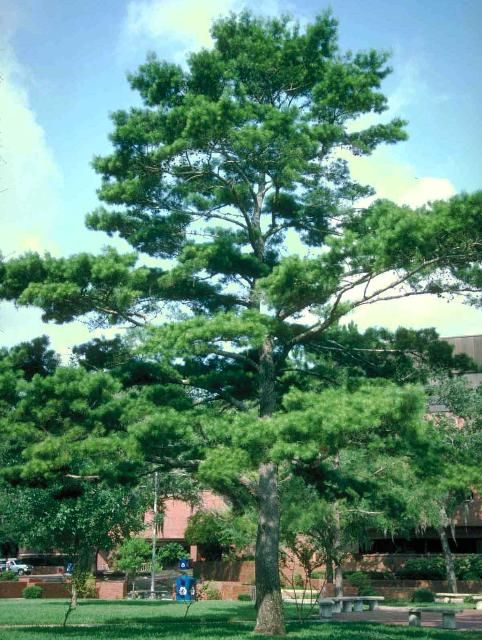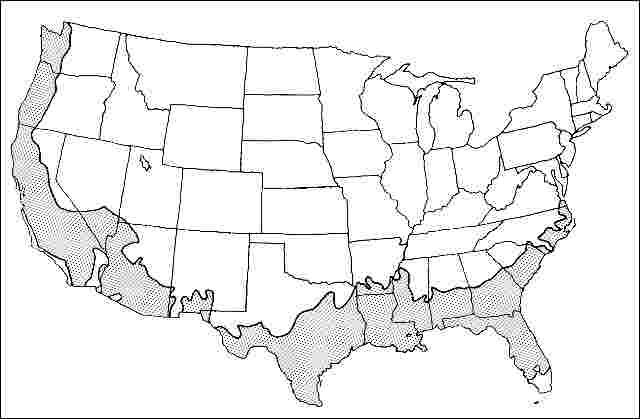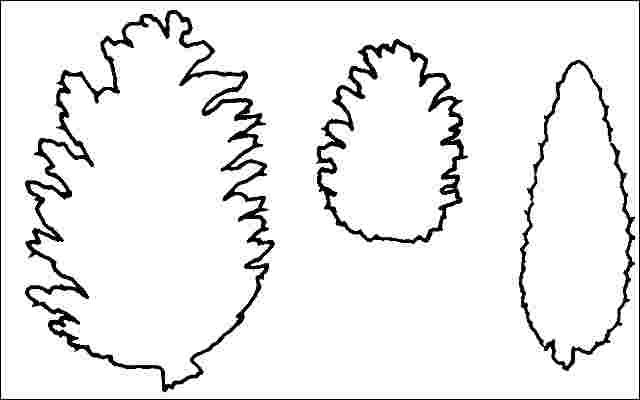Introduction
This heavily-foliated, much-branched evergreen has a bushy, irregular canopy of dark green, soft, 2- to 3-inch, twisted needles and a trunk that often becomes twisted and curved with age. Do not expect a row of spruce pine to form a uniformly-shaped canopy of pine needles. The lower branches on spruce pine making it ideal for use as a windbreak, large-scale screen or specimen and also creates light shade beneath larger trees. Although capable of reaching 80 feet in height in the woods, spruce pine is often seen at 30 to 50 feet when grown in the open and grows slowly. The reddish grey-brown bark has shallow ridges and furrows. The 2.5-inch-diameter cones remain on the branches for three to four years and are a source of food for wildlife.

Credit: Ed Gilman, UF/IFAS
General Information
Scientific name: Pinus glabra
Pronunciation: PIE-nus GLAY-bruh
Common name(s): Spruce pine
Family: Pinaceae
USDA hardiness zones: 8A through 9B (Fig. 2)
Origin: native to North America
Invasive potential: little invasive potential
Uses: specimen; shade; reclamation; parking lot island < 100 sq ft; parking lot island 100–200 sq ft; parking lot island > 200 sq ft; street without sidewalk; tree lawn 4–6 feet wide; tree lawn > 6 ft wide; highway median; bonsai; Christmas tree
Availability: not native to North America

Description
Height: 30 to 60 feet
Spread: 25 to 40 feet
Crown uniformity: irregular
Crown shape: round, oval
Crown density: moderate
Growth rate: slow
Texture: fine
Foliage
Leaf arrangement: alternate (Fig. 3)
Leaf type: simple
Leaf margin: entire
Leaf shape: needle-like (filiform)
Leaf venation: parallel
Leaf type and persistence: evergreen, needled evergreen, fragrant
Leaf blade length: 2 to 4 inches
Leaf color: green
Fall color: no color change
Fall characteristic: not showy

Flower
Flower color: yellow
Flower characteristics: not showy
Fruit
Fruit shape: oval, cone
Fruit length: 1 to 3 inches
Fruit covering: dry or hard
Fruit color: brown
Fruit characteristics: attracts squirrels/mammals; showy; fruit/leaves a litter problem
Trunk and Branches
Trunk/bark/branches: branches don't droop; not showy; typically one trunk; thorns
Pruning requirement: little required
Breakage: resistant
Current year twig color: brown
Current year twig thickness: thin
Wood specific gravity: 0.44
Culture
Light requirement: full sun, partial sun, or partial shade
Soil tolerances: clay; sand; loam; slightly alkaline; acidic; extended flooding; well-drained
Drought tolerance: moderate
Aerosol salt tolerance: low
Other
Roots: not a problem
Winter interest: no
Outstanding tree: no
Ozone sensitivity: unknown
Verticillium wilt susceptibility: resistant
Pest resistance: resistant to pests/diseases
Use and Management
Growing in full sun on moist fertile soils, this North American native will also tolerate poor, dry soils, as well as wet sites better than other pines. Many people forget how picturesque this pine can become as it grows older. It should be used more as specimen tree. Pines are deep-rooted except on poorly-drained sites where there will be only shallow roots. The tap root can make them difficult to transplant from the wild.
Pines grow best on acid soil and are usually not recommended for planting in soil which have a high soil pH. Grows best without grass competition. Spruce pine is unusual among the pines in that it will grow in partial shade.
Propagation is by seed.
Pests
Some adelgids will appear as white cottony growths on the bark. All types produce honeydew which may support sooty mold. European pine shoot moth causes young shoots to fall over. Infested shoots may exude resin. The insects can be found in the shoots during May. Pesticides are only effective when caterpillars are moving from overwintering sites to new shoots. This occurs when needle growth is about half developed.
Bark beetles bore into trunks making small holes scattered up and down the trunk. Stressed trees are more susceptible to attack. The holes look like shotholes. Keep trees healthy.
Sawfly larvae are variously colored but generally feed in groups on the needles. Some sawfly larvae will flex or rear back in unison when disturbed. Sawflies can cause rapid defoliation of branches if left unchecked.
Pine needle miner larvae feed inside needles causing them to turn yellow and dry up.
Pine needle scale is a white, elongated scale found on the needles. Pine tortoise scale is brown and found on twigs. Depending on the scale, horticultural oil may control overwintering stages.
Pine spittle bug lives and hides in a foamy mass but is relatively harmless.
Spruce mites cause damage to older needles, and are usually active in the spring and fall. Mites cause older needles to become yellowed or stippled.
Diseases
Resistant to fusiform rust. Canker diseases may occasionally cause dieback of landscape pines. Keep trees healthy and prune out the infected branches.